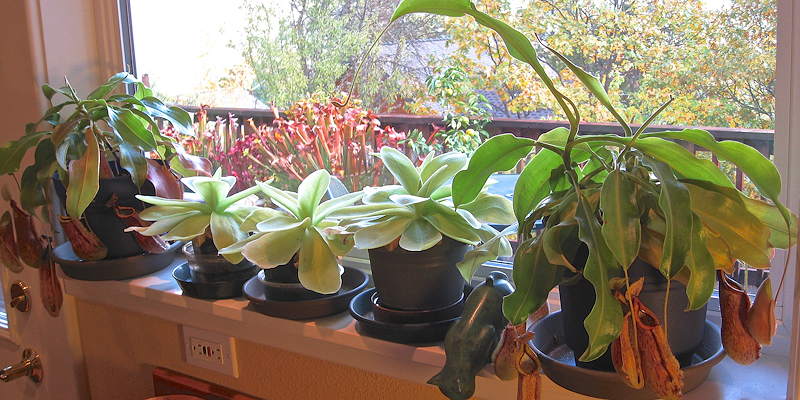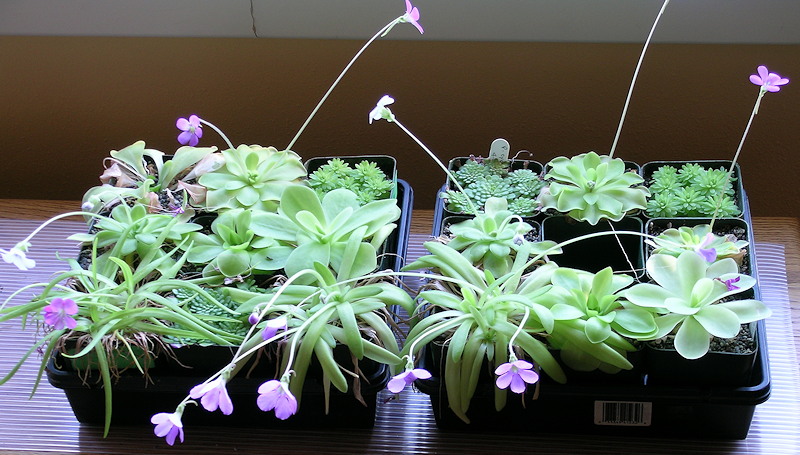Window sills and furniture below windows or in front of glass doors make a great place to grow certain carnivorous plants. For a window sill you need a plant that does not require a lot of intense light and can handle the typically dry air inside a house. It is no surprise that Mexican Pinguicula do well in this kind of environment but many Nepenthes do nicely too.

Houses present unique challenges for growing plants. Unless you have a "modern" design house with high amounts of natural light or have an atrium or a sun room there are probably not many places in your house where you can grow plants that expect more than a minimal amount of light. Of course you can always put a light fixture above your window sill plants to supplement the light coming in the window. I do that for plants overwintering in a garage window. But for house plants in your living room it seems you either need to go full-on lighted terrarium or just have plants sitting on the sill. Who wants to have a light fixture in front of a window presuming you can do it in the first place.
A second challenge for growing carnivores as house plants is humidity. Most carnivorous plants do not require as much humidity as you might expect considering where they live in the wild. But if you live in a climate that requires heating in winter, where are the radiators, baseboard heaters, or heating air vents? They are right over or under the windows! So during the winter your plants alternate between a cold draft off the windows and a hot dry blast or at least warm dry draft from the heating system. And you can not always go by the technical humidity. Humidity is defined as the percent water saturation of the air. The higher the elevation the less water the air can hold at any given temperature. So higher elevations at the same relative humidity have less water in the air.
Temperature can be a challenge for house plant carnivores in the sense that even though you can use heating and cooling for your house, the most extreme temperatures in the house happen at the windows. I have had Nepenthes growth tips die from the cold draft off windows in the winter. And we are talking dual pane, low-E windows. The plants survived just fine, just forget new pitchers in the winter off those plants.
Mexican Pinguicula are probably the best candidates for house plant carnivores. Any bright window with some direct sun will work. I use a heavier soil mix than would be advised for plants in a greenhouse and keep the pots always sitting in water. The leaves are more green than they would be in a greenhouse or under lights but the plants do very well. They grow and bloom and bloom. And in fact, if you can not grow the plants outside or do not have a greenhouse then the best place to grow Pings is as window sill plants. Pings need seasonal light queues in order to survive long term. It is hard to give them the light queues in a terrarium. One problem is most species have flowers that want to face the sun which is out the window so all you see is the back of the flowers. You can rotate the pots daily. P. gigantea is one species with flowers that do not bend toward the light.

You are not going to impress many of your non-carnivore friends with Pinguicula but generally a fine Nepenthes will get their attention, especially when you point out the pitchers where you have deposited dead flies. Which Nepenthes you can grow very much depends on temperature and humidity in the house. Basically the higher the humidity and temperature the more species that will do well. Light intensity may also be a factor for species that normally grow in full sun. With over 120 species and 1500 hybrids of Nepenthes known there are lots of possibilities. Generally lowland, partial sun species with thick, leathery leaves will stand up best to low humidity. Nepenthes rafflesiana, N. bicalcarata, and N. truncata are good lowland species for beginners. Highland, non-fog forest Nepenthes should also do well as they will not have problems with cool temperatures in the winter. Choices would include N. alata, N. khasiana, and N. ventricosa.
Nepenthes in the house will use much more water and dry out much too quickly to use standard planting medium recommended for greenhouse plants. You will need to use a heavier planting medium and larger pots. 100% long fibered Sphagnum is a little too heavy but you may need to use a mix of 75% Sphagnum to 25% perlite to keep your plants from drying out too quickly. It is also OK for the plants to sit in water for a day or two to give the Sphagnum time to absorb the water.
What about other plants that some CP nurseries advertise in "window sill" collections? If your house is humid enough and you have a window providing 4 hours of direct sun a day, that is great. Sarracenia rosea, Dionaea muscipula, Cephalotus follicularis, and many Drosera species may do well. You might even be able to grow certain Heliamphora species. I suspect those plants will really need some supplemental lighting since they really do want full sun. I have never been able to grow them as window sill plants and instead grow them in terrariums under 14 hours of light a day. You do not need a sealed terrarium, I make mine leaky so they do not fog up.
-- John Brittnacher
For more information please see:
D'Amato, Peter (1997) The Savage Garden Windowsill Growing. Carniv. Pl. Newslett. 26(1):20-23 ( PDF )
